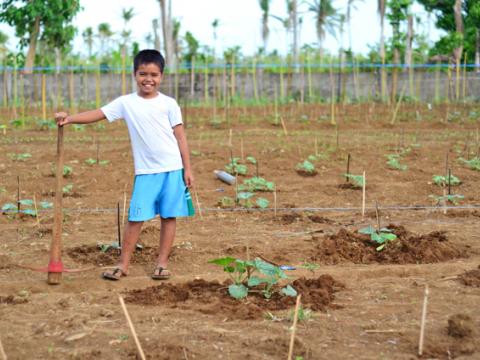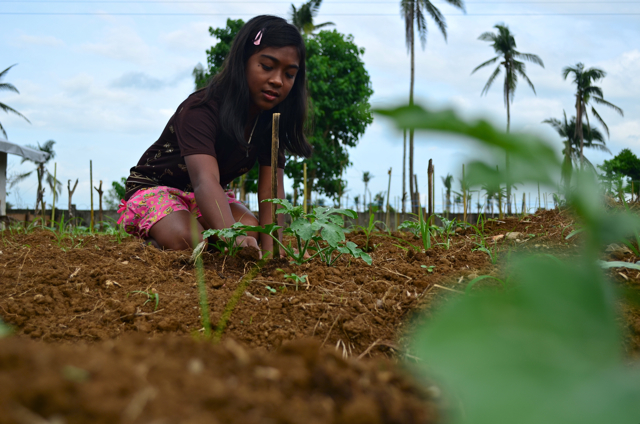Regrowth – How a Garden is Reviving a School

By Mark Nonkes, Regional Communications
Jericho is on his knees, pinching weeds from the soil.
A few minutes ago, the 11-year-old and two-dozen of his classmates filled old plastic bottles and watered the sprouting tomatos, watermelon and cucumbers.
This month-old school garden is teaching children in Grade 3, 4, 5 and 6 how to grow a thriving green space, filled with healthy vegetables.
“When they’re ready to harvest, the children will pick them. The vegetables will be part of the food we provide them at the school. Extra ones we’ll sell for the school development fund,” says Luel A Balnsag, an agriculture teacher.
After the storm, all the plants were destroyed, the fruit trees too.
The garden was created after a World Vision Cash for Work project set food in the village - aiming to help communities recover from Typhoon Haiyan and providing the worst affected by the storm with temporary income.
It’s also tackling child malnutrition; something the teachers in this rural Leyte school say is a growing problem.
“After the typhoon, all the vegetables were destroyed. Children started eating more junkfood. It’s affecting their health,” Luel says. “Junkfood is much cheaper than buying fruit or vegetables.”
The children in the gardening club are learning the importance of growing their own food, how to garden organically and how vegetables improve their health.
“Now we know how to plant, how to weed and how to grow seedlings,” says 12-year-old Justine, a gardening club member.
“We know how to make seed boxes, identify plants and make organic fertilizer too,” adds Jessa Mae, another gardening club member.
This Dagami area school saw its roofs ripped off during the storm. Teaching material and schoolbooks were soaked. Most school children are now living in a home that was partially or totally damaged during the storm.
The school’s garden was mowed down too in the storm and covered with debris – leaves, branches and broken off bits of the school.
“After the storm, all the plants were destroyed, the fruit trees too,” Jessa Mae says.
World Vision worked with the village leaders and school principal to identify this project as a priority for the community’s recovery from Typhoon Haiyan.
Over the course of 10-days, a dozen Haiyan survivors cleared debris, hoed the soil and planted seeds. One parent even harnessed his water buffalo and cultivated the ground. After the work was concluded, a huge garden stood beside the school. For their work, the beneficiaries were paid 2,600 PSP – in line with the local minimum wage.
With the work complete, 92 children joined the school gardening activities – designed to provide children with hands on learning on life sciences and grow food that will benefit their growth.
In a month’s time, the teachers and school children are looking forward to the first harvest.
“We’re not just teaching the children, we’re teaching their parents as well. People stop here everyday to find out what we’re doing. The culture of growing vegetables isn’t very strong in this community,” Luel says.
Officials from the Department of Education are also taking note. Luel reports there is ongoing conversation about extending the gardening project to other communities in Leyte.
